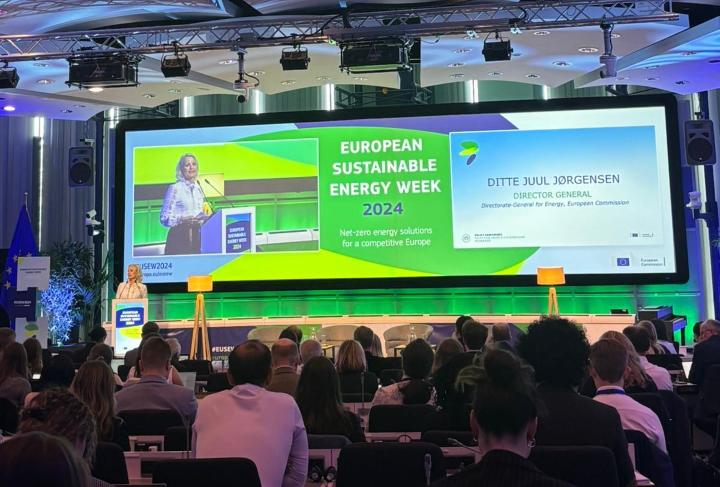The European Sustainable Energy Week (EUSEW) 2024 focused on "net-zero energy solutions for a competitive Europe." With over 10,000 attendees, the event took place from June 11-13 in Brussels, spotlighting Europe's clean energy transition and competitiveness. Airborne wind energy (AWE) is a promising innovation that can make the renewable energy mix more robust, agile, and resilient. Additionally, it can enhance the competitiveness of the European start-up and innovation ecosystem, supporting the goals of a circular economy and inclusive energy transition.
So, how would that work exactly? The DEM-AWE project team gathered key points from EUSEW 2024 and discussed how airborne wind energy could contribute to the European energy transition agenda.
The net zero transition: what are we up against?
The transition to a sustainable energy future is the grand challenge of our time. This evolution will not only help contain climate change but also rewire our societies, prioritizing human development and environmental care. Achieving net zero emissions requires engagement from all sectors of society, from policymakers to citizens, ensuring inclusive participation and effective knowledge management. Net-zero strategies need to be holistic, addressing multiple objectives such as enhancing energy security, reducing emissions, strengthening climate adaptation, and fostering a circular economy.
Airborne wind energy can address many of these points and contribute to the net-zero transition in Europe and beyond. With its effective energy conversion, AWE technology has the potential to drive down emissions in sectors like construction and agriculture while delivering green power to areas that are expensive and hard to reach with conventional grid infrastructure. Additionally, airborne wind does not require huge quantities of raw materials and can fill the gaps in the energy profiles of wind and solar, contributing to a more stable energy system. It also creates new high-tech employment opportunities and boosts business, healthcare, education, and wellbeing, strengthening the European economy.
Energy transition requires collective action
The net zero transition is not just a technological challenge; it is also a societal one. It is crucial to develop and implement policies that drive the transition towards net zero emissions. This includes setting and achieving renewable energy targets, providing incentives for renewable energy adoption, and enhancing regulations that support climate goals.
The role of citizens is equally important. Public awareness and participation are crucial for the success of climate and energy policies. When citizens are informed and engaged, they can drive demand for cleaner energy options like AWE, adopt sustainable practices, and support community-based energy projects.
As an innovative and scalable renewable energy source, airborne wind energy can strengthen climate action and provide a blueprint for integrating innovative small-scale renewable energy solutions into our energy policies. Additionally, with its benefits of relatively easy installation and operation, as well as the ability to generate green electricity in remote locations, airborne wind energy can help decentralize clean power production. This empowers local actors and citizens, strengthens energy democracy, and deepens the energy transition, helping to restructure our energy systems.

Diverse energy sources enhance energy security
In the face of international political crises combined with climate breakdown, energy security, resilience, and independence have become fundamental. While energy independence rests on having control over your energy resources, resilience involves ensuring multiple energy sources, distributed energy systems, and emergency operation protocols. By diversifying energy sources and investing in renewable energy technologies such as AWE, we can reduce our dependence on fossil fuels, enhance our energy security, and strengthen our climate mitigation and adaptation abilities.
With its ability to produce energy off-grid and in emergencies, and its energy profile that generates power from high-altitude winds, airborne wind energy can support energy security strategies.
Investing in energy transition ensures sustainable future
The transition to a sustainable energy future requires substantial financial investments. However, the costs of damages from the impacts of climate change are mounting. For example, the European Commission estimates that the EU lost €145 billion during the past decade due to climate change.
Investing in energy transition is about future-proofing. By prioritizing investments in clean energy, including innovative solutions like AWE, we can accelerate the net-zero transition, generate new jobs, and stimulate economic growth, all while reducing greenhouse gas emissions. The experience from wind and solar industries, along with the significant reduction in prices, offers an encouraging precedent. Wind and solar have become very competitive, and new technologies like AWE offer a less crowded investment field. The investment needed to mature the airborne wind energy industry is on par with a single 1.2 GW offshore wind park.
Innovative renewable energy technology make Europe more competetive
Renewable energy enhances Europe's competitiveness by reducing energy costs, fostering innovation, and ensuring energy security. The development of advanced technologies helps create green jobs, driving economic development and positioning Europe as a leader in the global green economy.
Airborne wind energy technology produces renewable electricity from a previously untapped resource and can give Europe a competitive advantage. Currently, most of the airborne wind energy developers and start-ups are based in Europe, and they have already formed a vibrant industry association. These conditions give Europe an upper hand in the development and implementation of this technology, offering a unique opportunity to advance climate action and boost Europe’s position in global technology leadership.
The pathway to achieving net zero emissions is complex and challenging, requiring significant efforts from policymakers, citizens, and all sectors of society. By enhancing energy security, investing in renewable energy and innovation, and fostering inclusive energy communities, Europe can build a sustainable energy future. Integrating airborne wind energy into the energy transition would help mitigate the impacts of climate change, increase the competitiveness of European economies, and support human development simultaneously.